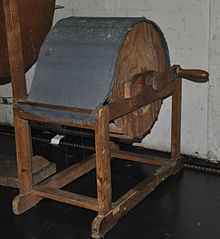Wind machine
For the agricultural device, see Frost Protection Methods.


The wind machine (also called aeoliphone) is a friction idiophone, which is a class of instrument which produces sound through vibrations within the instrument itself.[1] It is a specialist musical instrument used to produce the sound of wind in orchestral compositions and musical theater productions.[2]
Construction
The wind machine is constructed of a large cylinder made up of several wooden slats which measures approximately 75–80 centimeters in diameter.[2][3] The cylinder body of the instrument rests upon a stand and is typically covered with silk, canvas, or other material which is in a fixed position. A crank handle, used by the player to rotate the cylinder and create the sound, is attached to the cylinder.[1]
Another method of construction implements an electric fan, which is fitted with lengths of cane, rather than blades. However, this method is less popular because it does not provide the player with the ability to control the speed of rotation.
Technique
The wind machine is played by rotating the crank handle, which is attached to the cylinder, to create friction between the wooden slats and the material covering that touches the cylinder but does not rotate as the crank handle is turned. This friction between the wood and the material covering creates the sound of rushing wind.[2] The volume and pitch of the sound is controlled by the rate at which the crank is turned. The faster the handle is turned, the higher the resulting pitch and the louder the sound. The slower the handle is turned, the lower the pitch and the softer the volume. The sound of the wind machine can also be controlled by the tightness of the fabric covering the cylinder.[2][4]
Classical works that use the instrument
- Jean-Philippe Rameau: Les Boréades
- Giacomo Puccini: La Fanciulla del West
- Gioachino Rossini: The Barber of Seville
- Richard Wagner: Der fliegende Holländer
- Richard Strauss: Don Quixote,[5][6] Eine Alpensinfonie (An Alpine Symphony),[6] Josephslegende (1914),[6] Die ägyptische Helena, and Die Frau ohne Schatten[6]
- Edward Elgar: The Starlight Express
- Maurice Ravel: Daphnis et Chloé,[7][5] L'enfant et les sortilèges, The orchestration version of Gaspard de la nuit - Scarbo
- Gottfried Huppertz: "Chronicles of the Gray House"
- Olivier Messiaen: Des canyons aux étoiles…,[7] Saint François d'Assise and Éclairs sur l'au-delà…
- Arnold Schoenberg: Die Jakobsleiter[1]
- Darius Milhaud: Les choëphores[1]
- Benjamin Britten: Noye's Fludde
- Gyorgy Ligeti: Le Grand Macabre
- Ralph Vaughan Williams: Sinfonia antartica[5]
- Ferde Grofé: Grand Canyon Suite
- Jerry Goldsmith: The Blue Max
- Philip Sparke: Music Of The Spheres
- Roger Cichy: First Flights
- Fazıl Say: Symphony No 3 Universe
- Michael Tippett: Symphony No. 4[5]
In popular music
- The Beatles: The instrument creeps in during the 3 minute guitar loop in the song "I Want You (She's So Heavy)" from the album Abbey Road (1969).
- Pink Floyd: The instrumental piece "One of These Days" from the album Meddle (1971).
References
- ^ a b c d Baines, Anthony, The Oxford Companion to Musical Instruments, (New York: Oxford University Press, 1992), 104, 173. ISBN 9780193113343.
- ^ a b c d Peinkofer, Karl and Fritz Tannigel, Handbook of Percussion Instruments, (Mainz, Germany: Schott, 1976), 16, 172-173.
- ^ Blades, James, Percussion Instruments and their History, (Westport, CT: Bold Strummer, 1992), 346, 394-395. ISBN 9780933224612.
- ^ James Blades and James Holland. "Wind machine." Grove Music Online. Oxford Music Online. Oxford University Press, accessed October 5, 2014, http://www.oxfordmusiconline.com/subscriber/article/grove/music/30403.
- ^ a b c d Jones, Barrie (2014). The Hutchinson Concise Dictionary of Music, p.731. Routledge. ISBN 9781135950187.
- ^ a b c d Peinkofer and Tannigel (1976), p.172.
- ^ a b Chion, Michel (2015). Sound: An Acoulogical Treatise, unpaginated. Duke University. ISBN 9780822374824.
Further reading
- The Ultimate Encyclopedia of Musical Instruments, ISBN 1-85868-185-5, p. 109
